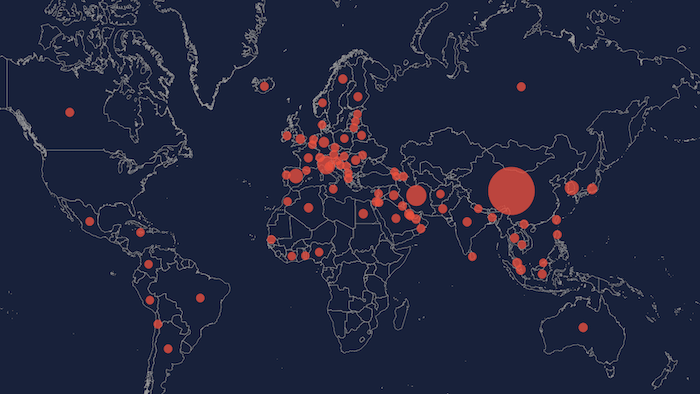SUMMARY
This is AI generated summarization, which may have errors. For context, always refer to the full article.


MANILA, Philippines – The coronavirus disease, COVID-19, may prove to be our generation’s biggest public health crisis, bringing the world to its knees in just three months. Starting with an outbreak of 41 cases in Wuhan, China, the virus has since spread rapidly around the globe, upending lives and affecting the global economy.
Read more coronavirus outbreak stories here.
As of March 22, 2020, the number of confirmed cases has risen to over 300,000 worldwide. China, ground zero for the virus, has recorded the highest number of infections at over 81,000. The virus – spread mainly through human transmission – has since crossed borders, hitting even the world’s most affluent western regions.
Italy, whose tally of deaths and confirmed cases keeps rising as of writing, has overtaken China as the worst-hit by COVID-19 in terms of fatalities. As of March 20, the country has already lost more than 4,000 lives to the virus, surpassing China’s over 3,200 death toll.
The rest of the world scrambles to avoid the same fate, with several countries mulling, if not already imposing, draconian containment policies. Measures to contain the virus put a strain on economies worldwide, with JP Morgan economists expecting the global economy to “experience an unprecedented contraction during the first half of the year.”
Full screen button on the lower right of the dashboard.
The Philippines and COVID-19
The Philippines has not been spared from the virus. It had its first confirmed case in February (the first outside China), and this has risen by the hundreds in a little over a month, causing the Philippine government to put the country on lockdown, imposing the strictest containment measure against the virus in Southeast Asia.
Get more local data on COVID-19 here. Click on the areas to see more specific data.
As of Sunday evening, March 22, the Philippines recorded 380 confirmed cases with 25 deaths.
This puts the fatality rate at around 6.5% for the Philippines, higher than the global average. However, this may not be an accurate representation of the fatality rate in the country, because the Philippines suffers from inadequate test kits, testing only in severe to critical cases.
The case for massive testing
As fear of the virus spreads across the archipelago, so are demands for the government to conduct massive testing, similar to how its Asian neighbors have dealt with the virus.
Data curated by Our World In Data shows that the Philippines lags behind other countries in terms of tests conducted.
South Korea, among the first countries to be hit by COVID-19 outside China, has conducted the most number of tests by a country. As of March 20, the country has conducted 316,664 tests for infection. The Philippines, for the same period, recorded only 1,269 tests.
Experts say this contributes to a deflated reporting of cases in the Philippines. Our World In Data’s analysis shows that countries with higher rates of confirmed cases tend to be also countries where a larger share of the total population has been tested.
Laid against population data, numbers as of March 20, 2020 show that the Philippines has been conducting only around 12 tests for every million people. This is far behind countries like the United Arab Emirates, which performs almost 13,000 tests per million people. It’s also behind Asian neighbors like Malaysia (422 per million people) and Vietnam (159 per million people).
If tests are not carried out, it becomes harder for countries to see big picture scenarios and lay down measures to reduce the spread of the virus. People who do not know they’re sick might also not get the medical assistance they need and even fail to impose self-quarantine.
The massive testing conducted in South Korea has been hailed worldwide as a model response to the outbreak. The country’s breakthrough success in “flattening the curve” has been attributed largely to its government’s efforts to make testing for the virus accessible for everyone.
Since the start of the outbreak, South Korea had been indiscriminately testing its citizens, going as far as putting mass drive-thru testing centers. Results were released within the next 24 hours, and were followed by a rigorous contact tracing and quarantine process.
Filipinos have been upping pressure on the government to adapt similar methods. As of March 22, an online petition calling for massive testing has been signed by more than 78,000 Filipinos. The Department of Health (DOH) continues to maintain, however, that there is no need to conduct mass testing for coronavirus in the country.
A flicker of hope comes as more than 100,000 new test kits from other countries arrived in the Philippines. Test kits developed by scientists of the University of the Philippines are also currently being validated, according to the DOH. – Global dashboard by Ralph Sebastian Nodalo/Rappler.com
*COVID-19 testing data originally published by Our World In Data here. Visualizations were remade to highlight Philippine numbers. Some countries have been omitted in the charts because available data on testing has not been updated since February.
**This story was done in partnership with TheNerve, a Manila-based consultancy that specializes in bringing together valuable data insights and meaningful narratives. Believing that data is key to delivering real-world impact, the company enables its partners across a wide range of sectors to cut through the data clutter and unravel insights to create narratives that matter to their communities.
integrity=”sha512-xwE/Az9zrjBIphAcBb3F6JVqxf46+CDLwfLMHloNu6KEQCAWi6HcDUbeOfBIptF7tcCzusKFjFw2yuvEpDL9wQ==”
crossorigin=”” />
integrity=”sha512-gZwIG9x3wUXg2hdXF6+rVkLF/0Vi9U8D2Ntg4Ga5I5BZpVkVxlJWbSQtXPSiUTtC0TjtGOmxa1AJPuV0CPthew==”
crossorigin=””>
Add a comment
How does this make you feel?
There are no comments yet. Add your comment to start the conversation.